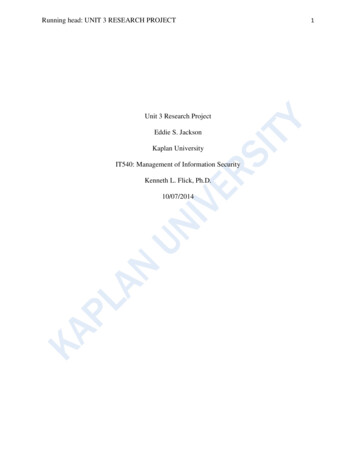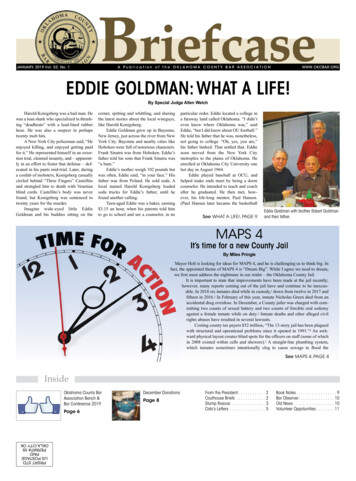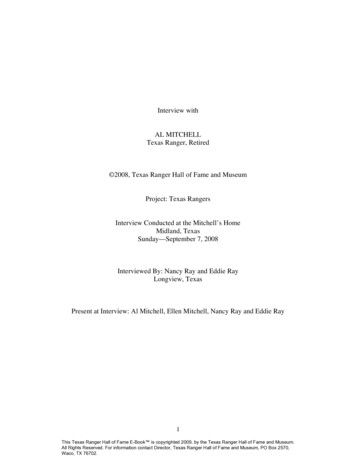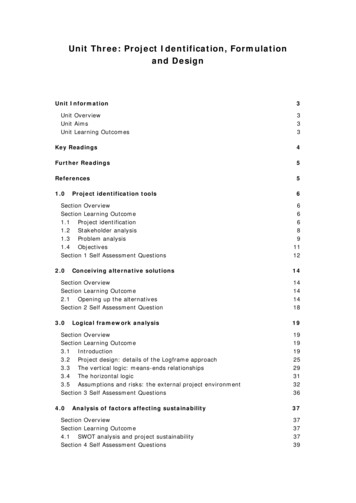
Transcription
Running head: UNIT 3 RESEARCH PROJECTUnit 3 Research ProjectEddie S. JacksonKaplan UniversityIT540: Management of Information SecurityKenneth L. Flick, Ph.D.10/07/20141
2UNIT 3 RESEARCH PROJECTTable of ContentsAbstract . . 3Part I . . . . . 4Host Detail Screen . .4BASE Alerts Detail Screen . . 5Individual BASE Alert Detail Screen . . 6ATTACK RESPONSE on BASE Alert Screen . . 7Part II. . . . . . . . . 7Assessing the Compromised Server . . . 8Checking Files . . 8Checking Network Activity . 9Checking Possible Vulnerabilities . . 10Checking Network Account Activity .11Protecting Network Resources . . 11References . . . .13
3UNIT 3 RESEARCH PROJECTAbstractThe unit three research project presents a two-part assignment that relates to computer forensics,which encompasses the steps and tools that are required for incident response and attackprevention. Both parts of the assignment are meant to reinforce the fundamental conceptsassociated with forensic science. In Part I, there is a hands-on Snort lab. The Snort lab exercise isa real-world scenario that allows the student to become familiar with Snort software, and in turnlearn to scan a network stream, capture alerts, and assess specific alert types. In Part II of theassignment, the student is asked to assess a hypothetical server break-in, and respond in essayform to a series of questions. These questions are intended to highlight the steps and toolsutilized in network resource protection.
4UNIT 3 RESEARCH PROJECTUnit 3 Research ProjectPart IThe Jones & Bartlett Lab. In this lab, Snort was used in incident handling. See snapshotsbelow.Screen capture of the host detail screen from the Lab #10 SNORT Scan:
UNIT 3 RESEARCH PROJECTScreen capture of the BASE alerts detail screen:5
UNIT 3 RESEARCH PROJECTScreen capture of an individual BASE alert detail:6
7UNIT 3 RESEARCH PROJECTScreen capture of an ATTACK RESPONSE on the BASE alert detail screen:Part IIThe break-in. In the second part of the assignment, there is a hypothetical break-in whichrequires a five question assessment. Each question explores the ideas and concepts of computerforensics.
UNIT 3 RESEARCH PROJECT8What are the steps and tools used in assessing a compromised server? Whenhackers compromise servers, sometimes there are obvious signs of malicious activity, andsometimes the exploits are more stealth. In either case, the information security officer, uponnotification that something is wrong with a server, must have a plan for assessing a compromisedserver; this plan contains the steps or tools necessary to determine exactly what damaged hasbeen done to the server. Considering the break-in, the first step the information security officershould take is verifying that the server has indeed been compromised (Obialero, 2005). Thisverification can be a visual inspection of the running processes and network activity using aprocess manager; on Microsoft-based operating systems, this is called the task manager(Microsoft, n.d., para. 1).A second technique for assessing a compromised server would be to scan the system toverify the integrity of the files. For example, in Microsoft operating systems, there is a systemfile checker (sfc) which can be executed to scan, report, and even repair compromised files(Microsoft TechNet, n.d. para. 1). If this server is a domain controller running Microsoft’sActive Directory, and audit access has been defined, the event properties of the object can beaccessed and reviewed in the Event Viewer (Levin, 2007). Finally, other tools such as anti-virusscanners and malware scanners can also be utilized to scan a server to validate whether or not theserver has been compromised.Which files would be checked? Of course, knowing exactly which files should bechecked for integrity is critical to the overall assessment of the compromised server. Hackerstarget particular areas of an operating; these areas contain the required system files and essentialservices. System files are file types that end in DLL, OCX, and EXE. Server services are usuallyassociated with these file types as well. To check the integrity of files and services, forensic
UNIT 3 RESEARCH PROJECT9applications, such as those from NirSoft, can be used to verify integrity. For example, NirSoft’sRegDllView utility scans registered DLL, OCX, and EXE files. Additionally, RegDllViewreturns when the files were registered with the system, and provides a list of files that are nolonger needed (NirSoft, 2014).If this server is a web server, it is possible that hackers may have compromised theserver through web-based services. A common web server attack is where a hacker uses CrossSite Scripting, or XSS, to modify server scripts and web pages that will be accessed by otherusers (Valentino, n.d.). The specific files that should be checked in an XSS attack are PHPscripts, session cookies, and other unknown or new scripts on the web server (Acunetix, n.d.).Likewise, webpages coded in HTML and CSS should be analyzed for any recent changes to theircontent.Where do you check for network activity? While it is crucial to identify which filesmay have been compromised in an attack, scanning and monitoring network activity is equallyimportant. When servers have been compromised, it is common that a hacker will opencommunication ports to be able to steal data or maintain open access to the server; unknownestablished connections to a server, or other network resource for that matter, can be an obvioussign of malicious activity. It is the responsibility of the security information officer to assessnetwork activity and determine whether or not these undesirable lines of communication exist.There are simple tools such as netstat which can be used for viewing open ports. When usingnetstat, there are options for displaying active TCP and UDP connections, Ethernet statistics, andport numbers. (Microsoft TechNet, n.d.).A more advanced approach to evaluating network activity would be to utilize packetanalyzers. Packet analyzers can peer into a network communication stream and allow an
UNIT 3 RESEARCH PROJECT10information security officer to assess and analyze data at the packet level. These features areparticularly important because source and destination IP addresses can be observed. The reasonthis is significant is because when hackers make connections to network resources, their sourceaddress can often be determined from analyzing packets in the bitstream. Similarly, unusualnetwork traffic, specific ports, as well as user-defined network protocols can be scrutinized forexisting threats (Rouse, n.d.). A popular application for analyzing packets is Wireshark.Wireshark has features such as saving network activity captures for later examination, setting upalerts, protocol filters, and support for multiple platforms (Wireshark, n.d.).Still, there are other methods for evaluating network traffic; for example, firewalls thathave auditing enabled and intrusion detecting systems (IDS). Firewalls normally act as a barrierof protection between an organization and the outside world–controlling incoming and outgoingconnections–however, firewalls such as the Cisco PIX firewall, can maintain event data andfirewall messages (IBM, n.d.). This stored data, which contains connection information, can beanalyzed in the event of a compromised server; thus offering another method of network activityassessment. One final technique for monitoring or reviewing network activity is the IDS. AnIDS, such as the Cisco Catalyst 6500 Series Intrusion Detection System (IDSM-2) Module,offers features that perform analysis across multiple network layers, and even has the ability toprevent attacks (Cisco, n.d.). It is important to note, no single network monitoring strategy isperfect; thus implementing a multi-tiered approach to scanning network activity is best practice.How do you check for possible vulnerabilities? Once network activity has beenscanned, the next step would be to determine possible vulnerabilities. Operating systems aresusceptible to many types of vulnerabilities, such as DLL, OCX, Distributed Component ObjectModel (DCOM), and Remote Procedure Call (RPC) exploits (Microsoft TechNet, n.d.). One
UNIT 3 RESEARCH PROJECT11method for defining weak spots in these areas is to use the Microsoft Baseline Security Analyzer(MBSA). The MBSA identifies missing security updates, common misconfigurations, as well aspossible threats due to unknown or modified system DLL and OCX files (Microsoft, n.d.).Another application that could be used in determining vulnerabilities is Symantec EndpointProtection (SEP). SEP is a suite of utilities that offers a plethora of features which include antivirus, spam removal, data loss protection, and host integrity (Symantec, n.d.). Additionally, SEPprovides a layered approach to deal with potential threats and performs threat analysis; thus, SEPprovides a best practice strategy for determining if vulnerabilities exists, how to remove them,and how to prevent future attacks.How do you track network account activity? After determining exactly what thevulnerabilities are, tracking network account activity becomes a necessity. Network accountactivity includes logging in, logging out, as well as the frequency of accessing networkresources. There are a couple of common methods for a network administrator to track networkactivity; one technique is to use Microsoft’s domain-level or local group policy. By accessing thegroup policy editor, and navigating to Computer Configuration\Windows Settings\SecuritySettings\Local Policies\Audit Policy, the audit account logon events can be configured; theaccount logon and logon audit policy should be enabled (Microsoft, n.d.). Another method fortracking logon events is to use third party software. ManageEngine sells ADAudit Plus softwarethat monitors user logins and logouts, generates reports, and has the ability to track a user acrossmultiple machines (ManageEngine, n.d.). Additionally, the ADAudit Plus software visuallyrepresents the login data, making it much easier to understand and track network accountactivity.How do you protect network resources? Lastly, it is critical to formulate an overall
UNIT 3 RESEARCH PROJECT12strategy to protect network resources. Some of the best methods for protecting the resources onthe network have already been highlighted. For instance, network resources need to be protectedagainst outside attacks; it is best practice to install a firewall to control, audit, and report onincoming and outgoing connections. Secondly, an IDS will provide the added benefit of beingable perform threat analysis and generate alerts on suspicious network activity. Likewise, everynetwork should be protected against viruses, worms, and spam. This is where implementing anenterprise-based solution, such as SEP, becomes critical to maintaining the integrity of networkresources. Finally, one essential component for protecting network resources is an updates andpatching server. Update servers, such as Windows Server Update Services (WSUS), allowsystem administrators to centrally manage which security updates, system updates, and patchesget deployed to workstations and servers throughout the enterprise (Microsoft TechNet, n.d.).The reason it is important to consistently update and patch machines on the network is tomaintain the highest levels of operating system integrity. Ultimately, no one piece of technologycan fully protect all network resources; thus, implementing multiple layers of technologythroughout the enterprise has become best practice.
13UNIT 3 RESEARCH PROJECTReferencesAcunetix. (n.d.). Cross-site Scripting (XSS) Attack. What is cross-site scripting? Retrieved -site-scripting/Cisco. (n.d.). Cisco Catalyst 6500 Series Intrusion Detection System (IDSM-2) Module.Retrieved from tem-idsm-2-services-module/index.htmlIBM. (n.d.). Configuring auditing for Cisco PIX firewall. Retrieved from Y 1.0.0/com.ibm.itcim.doc/tcim85 install197.html%23cspxfwLevin, Alik. (2007/4/1). File access auditing - I am not afraid of GPO. Retrieved Microsoft. (n.d.). Audit logon events. Retrieved from .aspxMicrosoft. (n.d.). Microsoft Baseline Security Analyzer 2.3 (for IT professionals). Retrievedfrom px?id 7558Microsoft. (n.d.). What is task manager? Retrieved from at-is-task-managerMicrosoft TechNet. (n.d.). Best practices for mitigating RPC and DCOM vulnerabilities.Retrieved from 6.aspxMicrosoft TechNet. (n.d.). Netstat. Retrieved from .aspx
UNIT 3 RESEARCH PROJECT14Microsoft TechNet. (n.d.). System file checker. Retrieved from .aspxMicrosoft TechNet. (n.d.). Windows Server Update Services. Retrieved er/bb332157.aspxNirSoft. (2014). RegDllView v1.58 - View registered dll/ocx/exe files on your system andregister DLL files from Explorer. Retrieved from http://www.nirsoft.net/utils/registered dll view.htmlObialero, Roberto. (2005). Forensic analysis of a compromised intranet server. Retrieved ver-1652Rouse, Margaret. (n.d.). Network analyzer (protocol analyzer or packet analyzer). Retrievedfrom network-analyzerSymantec. (n.d.). Symantec Endpoint Protection. Retrieved from no, Vishnu. (n.d.). Basic hacking via Cross Site Scripting (XSS) – The logic. Retrievedfrom /#sthash.tLAYK0Y7.dpbsWhitman, Michael E., & Mattord, Herbert J. (2011). Principles of Information Security. 4thedition. Independence, KY: Cengage.Wireshark. (n.d.). Wireshark frequently asked questions. Retrieved from https://www.wireshark.org/faq.html#q1.1
Settings\Local Policies\Audit Policy, the audit account logon events can be configured; the account logon and logon audit policy should be enabled (Microsoft, n.d.). Another method for tracking logon events is to use third party software. ManageEngine sells ADAudit Plus software











